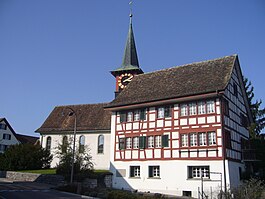Dietlikon
| Dietlikon | ||
|---|---|---|
 |
||
|
||
| Coordinates: 47°25′N 8°37′E / 47.417°N 8.617°ECoordinates: 47°25′N 8°37′E / 47.417°N 8.617°E | ||
| Country | Switzerland | |
| Canton | Zurich | |
| District | Bülach | |
| Area | ||
| • Total | 4.24 km2 (1.64 sq mi) | |
| Elevation | 445 m (1,460 ft) | |
| Population (Dec 2015) | ||
| • Total | 7,605 | |
| • Density | 1,800/km2 (4,600/sq mi) | |
| Postal code | 8305 | |
| SFOS number | 0054 | |
| Surrounded by | Bassersdorf, Dübendorf, Kloten, Wallisellen, Wangen-Brüttisellen | |
| Website |
www SFSO statistics |
|
Dietlikon is a municipality in the district of Bülach in the canton of Zürich in Switzerland, and belongs to the Glatt Valley (German: Glattal).
Dietlikon is first mentioned in 1124 as Dietlinchoven.
Dietlikon has an area of 4.2 km2 (1.6 sq mi). Of this area, 23.6% is used for agricultural purposes, while 31.1% is forested. Of the rest of the land, 44.1% is settled (buildings or roads) and the remainder (1.2%) is non-productive (rivers, glaciers or mountains).
The municipality is located on the edge of the middle Glatt Valley.
Dietlikon has a population (as of 31 December 2015) of 7,605. As of 2007[update], 21.8% of the population was made up of foreign nationals. Over the last 10 years the population has grown at a rate of 18%. Most of the population (as of 2000[update]) speaks German (83.7%), with Italian being second most common ( 5.2%) and Serbo-Croatian being third ( 2.0%).
In the 2007 election the most popular party was the SVP which received 36.4% of the vote. The next three most popular parties were the SPS (20.8%), the FDP (13.8%) and the CSP (9.7%).
The age distribution of the population (as of 2000[update]) is children and teenagers (0–19 years old) make up 20.5% of the population, while adults (20–64 years old) make up 65.3% and seniors (over 64 years old) make up 14.2%. In Dietlikon about 75.9% of the population (between age 25-64) have completed either non-mandatory upper secondary education or additional higher education (either university or a Fachhochschule).
...
Wikipedia




